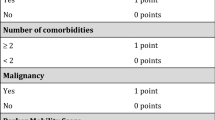Abstract
Purpose
This paper reports the external validation of a recently developed instrument, the Discharge of Hip fracture Patients score (DHP) that predicts discharge location on admission in patients living in their own home prior to hip fracture surgery.
Methods
The DHP (maximum score 100 points) was applied to 125 hip fracture patients aged 50 or more years admitted to an academic centre in the northern part of the Netherlands (Groningen cohort). The characteristics of this cohort, sensitivity, specificity and positive and negative predictive value (PPV, NPV) of the DHP for discharge to an alternative location (DAL) were calculated and compared with the original cohort of hip fracture patients from the western part of the Netherlands (Delft cohort). Scoring 30 points or higher indicated DAL.
Results
The Groningen cohort was younger compared to the Delft cohort, (mean age 75.4 vs. 78.5 years, P = 0.005) but was more often classified ASA III/IV (46.4 % vs. 25.2 %, P < 0.001). Sensitivity of the DHP for DAL in the Groningen cohort was 75 % (vs. 83.8 %), specificity of 66.7 % (vs. 64.7 %) and a PPV of 86.3 % (vs. 79.2 %), compared to the Delft cohort.
Conclusion
External validation of the DHP was successful; it predicted discharge location of hip fracture patients accurately in another Dutch cohort, the sensitivity for DAL was somewhat lower but the PPV higher. Therefore, the DHP score is a useful valid and easily applied instrument for general hip fracture populations.

Similar content being viewed by others
Abbreviations
- DHP:
-
Discharge of Hip fracture Patients score
- DAL:
-
Discharge to an Alternative Location
- ASA:
-
American Society of Anesthesiologists
- LOS:
-
Length of Stay
- ADL:
-
Activities of Daily Living
- SD:
-
Standard Deviation
- OR:
-
Odds Ratio
- CI:
-
Confidence Interval
- ROC:
-
Receiver Operating characteristics Curve
- AUC:
-
Area Under the Curve
- PPV:
-
Positve Predictive Value
- NPV:
-
Negative Predictive Value
- IQR:
-
InterQuartile Range
References
Cooper C, Campion G, Melton LJ (1992) Hip fractures in the elderly: a world-wide projection. Osteoporos Int 2:285–289
Cumming RG, Nevitt MC, Cummings SR (1997) Epidemiology of hip fractures. Epidemiol Rev 19:244–257
Haentjens P, Autier P, Barette M, Boonen S (2001) The economic cost of hip fractures among elderly women. A one-year, prospective, observational cohort study with matched-pair analysis. Belgian Hip Fracture Study Group. J Bone Joint Surg Am 83-A:493–500
Sahota O, Morgan N, Moran CG (2011) The direct cost of acute hip fracture care in care home residents in the UK. Osteoporos Int 23:917–920
O’Cathain A (1994) Evaluation of a hospital at home scheme for the early discharge of patients with fractured neck of femur. J Public Health Med 16:205–210
Parker MJ, Pryor GA, Myles JW (1991) Early discharge after hip fracture. Prospective 3-year study of 645 patients. Acta Orthop Scand 62:563–566
Vochteloo AJH, Tuinebreijer WE, Maier AB, Nelissen RGHH, Bloem RM, Pilot P (2012) Predicting discharge location of hip fracture patients; the new discharge of hip fracture patients score. Int Orthop 36:1709–1714
Nutritional anaemias. Report of a WHO scientific group. (1968) World Health Organ Tech Rep Ser 405:5–37
Owens W, Felts J (1978) ASA physical status classifications: a study of consistency of ratings. Anesthesiology 49:239–243
Kotz D, Nelemans P, van Schayck CP, Wesseling GJ (2008) External validation of a COPD diagnostic questionnaire. Eur Respir J 31:298–303
Vochteloo AJ, Moerman S, Tuinebreijer WE, Maier AB, de Vries MR, Bloem RM et al (2012) More than half of hip fracture patients do not regain mobility in the first postoperative year. Geriatr Gerontol Int, Jun 21. [Epub ahead of print]
Haentjens P, Lamraski G, Boonen S (2005) Costs and consequences of hip fracture occurrence in old age: an economic perspective. Disabil Rehabil 27:1129–1141
Merchant RA, Lui KL, Ismail NH, Wong HP, Sitoh YY (2005) The relationship between postoperative complications and outcomes after hip fracture surgery. Ann Acad Med Singapore 34:163–168
Foss NB, Palm H, Krasheninnikoff M, Kehlet H, Gebuhr P (2007) Impact of surgical complications on length of stay after hip fracture surgery. Injury 38:780–784
Keene J, Anderson C (1982) Hip fractures in the elderly. Discharge predictions with a functional rating scale. JAMA 248:564–567
Thorngren KG, Ceder L, Svensson K (1993) Predicting results of rehabilitation after hip fracture. A ten-year follow-up study. Clin Orthop Relat Res 287:76–78
Hashmi M, Tellisi N, Rigby A, Wahab K (2004) The value of a prognostic scoring system in the rehabilitation of elderly patients with proximal femoral fractures. Int J Clin Pract 58:2–5
Berglund-Rödén M, Swierstra BA, Wingstrand H, Thorngren KG (1994) Prospective comparison of hip fracture treatment: 856 cases followed for 4 months in The Netherlands and Sweden. Acta Orthop 65:287–294
Acknowledgments
The work was supported by the Netherlands Organisation for scientific research (NGI/NWO; 05040202 and 050-060-810 Netherlands Consortium for Healthy Aging (NCHA)) and the seventh framework program MYOAGE (HEALTH-2007-2.4.5-10) and Reumafonds LRR.
No competing interests declared.
Author information
Authors and Affiliations
Corresponding author
Rights and permissions
About this article
Cite this article
Vochteloo, A.J.H., Flikweert, E.R., Tuinebreijer, W.E. et al. External validation of the discharge of hip fracture patients score. International Orthopaedics (SICOT) 37, 477–482 (2013). https://doi.org/10.1007/s00264-012-1763-7
Received:
Accepted:
Published:
Issue Date:
DOI: https://doi.org/10.1007/s00264-012-1763-7




